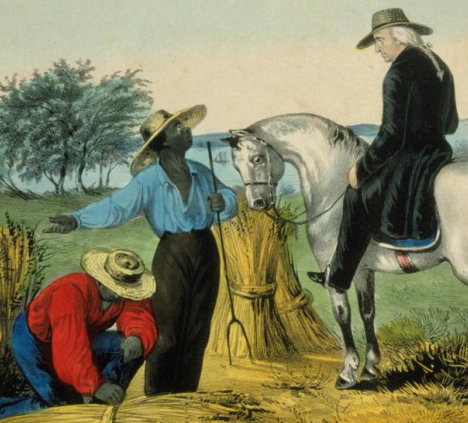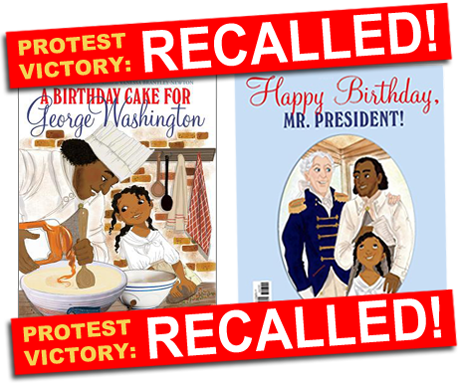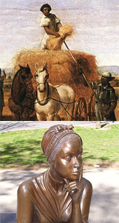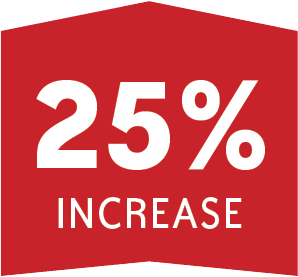| |
|
Zinn Education Project News
|
Rethinking Presidents' Day
|
Missing from Presidents' Day: The People They Enslaved
Schools across the country are adorned with posters of the 44 U.S. presidents and the years they served in office. U.S. history textbooks describe the accomplishments and challenges of the major presidential administrations. Nowhere in all this information is there any mention of the fact that more than
one in four U.S. presidents were involved in human trafficking and slavery. These presidents bought, sold, and bred enslaved people for profit. Of the 12 presidents who were enslavers, more than half kept people in bondage at the White House.
Continue reading.
|

Time to Tell the Truth About Slavery
At the time of George Washington's death, the Washingtons enslaved 318 people of African descent at Mount Vernon, according to the Mount Vernon Ladies' Association. But you would not know it from the main tour, nor from the brochure. In fact, most visitors, including schoolchildren, can spend hours admiring the Mount Vernon mansion, fine furniture, and manicured lawns without considering that it was all paid for with forced labor. Continue reading.
|
Rethinkin' Lincoln and the
Emancipation Proclamation
By Bill Bigelow
Here's a history quiz to use with people you run into today: Ask them who ended slavery. I taught high school U.S. history for almost 30 years, and as we began our study, students knew the obvious answer: Abraham Lincoln. But by the time our study ended, several weeks later, their "Who ended slavery?" essays were more diverse, more complex
----and more accurate. Teachers' jobs will be made harder by the film
Lincoln, in which Daniel Day-Lewis gives a brilliant performance as Lincoln-the-abolitionist. The only problem is that Lincoln was not an abolitionist.
Continue reading.
|

Under Pressure, Scholastic Recalls Racist Children's Book
By Deborah Menkart
A firestorm erupted when Scholastic released a children's book early this month,
A Birthday Cake for George Washington, featuring smiling slaves baking a cake for George Washington. The back cover portrayed George Washington and his enslaved chef, Hercules, arm-in-arm, like best buddies. The image convinced many that this was an
Onion parody and not an actual children's book published in 2016.
Continue reading.
|

Constitution Role Play: Whose 'More Perfect Union'? and The Constitutional Convention: Who Really Won?
Teaching Activity. By Bill Bigelow. A role play on the issues involved with the framing of the Constitution. Read more.
|

Andrew Jackson and the "Children of the Forest"
Teaching Activity. By Bill Bigelow. A lesson in which students develop critical literacy skills by responding to Andrew Jackson's speech on "Indian Removal." Read more.
|
|
Black History Month
|
Carter G. Woodson Launches
Negro History Week
Article. By Daryl Michael Scott.
"It is commonly said that Woodson selected February to encompass the birthdays of two Americans who played a role in shaping Black history, namely Abraham Lincoln and
Frederick Douglass, whose birthdays are the 12th and the 14th, respectively. Woodson built Negro History Week around traditional days of commemorating the Black past."
Continue reading.
|
Stripmining Black History Month
Article. By Jeff Biggers.
"As schools, communities and politicians across the country celebrate Black History Month, they will be remiss if their lessons don't include the coal fields of Fayette County, West Virginia. There, in the 1890s, a teenage Carter Woodson would gather with other Black coal miners, read the newspaper, and listen to their extraordinary stories of life underground, and their struggles during the Civil War and Reconstruction era."
Continue reading.
|
Black Abolitionists
Profile. By Zinn Education Project.
Textbooks and state curricula devote little attention to the abolition movement, let alone to Black abolitionists. To counter the invisibility of Black abolitionists who were central to the abolition movement and the ending of slavery, we feature two dozen Black abolitionists.
|
'What We Want, What We Believe': Teaching with the Black Panthers'
Ten Point Program
Teaching Activity. By Wayne Au.
The author describes how he used a study of the Black Panther's Ten Point Program to help students assess issues in their own communities and to develop Ten Point Programs of their own. Available in Spanish.
Continue reading.
|
Tremendous Growth in 2015
|
Thanks to your support, in 2015 the Zinn Education Project grew by:

11,000 registered
teachers
|

43,000
downloaded
lessons
|

93,000 Facebook fans
|
and reached millions more students.
|
|
Upcoming Conferences
|
Meet the Zinn Education Project at Upcoming Conferences
Mar. 19, 2016 |New York
|
We encourage you to apply to present at the National Council for the Social Studies conference (NCSS) being held this December in Washington, D.C. Each year the Zinn Education Project has a booth at the conference. We would like to see more people's history workshops in the program. We recommend that you apply for the one-hour sessions, with a hands-on, participatory workshop. Application Form
|
|
|
|
|
 |
The goal of the Zinn Education Project is to introduce students to a more accurate, complex, and engaging understanding of United States history.
|
|
|
|
|
|
|
|
|
© 2016 The Zinn Education Project, a collaboration of
|
 |
and
|
 |
.
|
|
| |
|